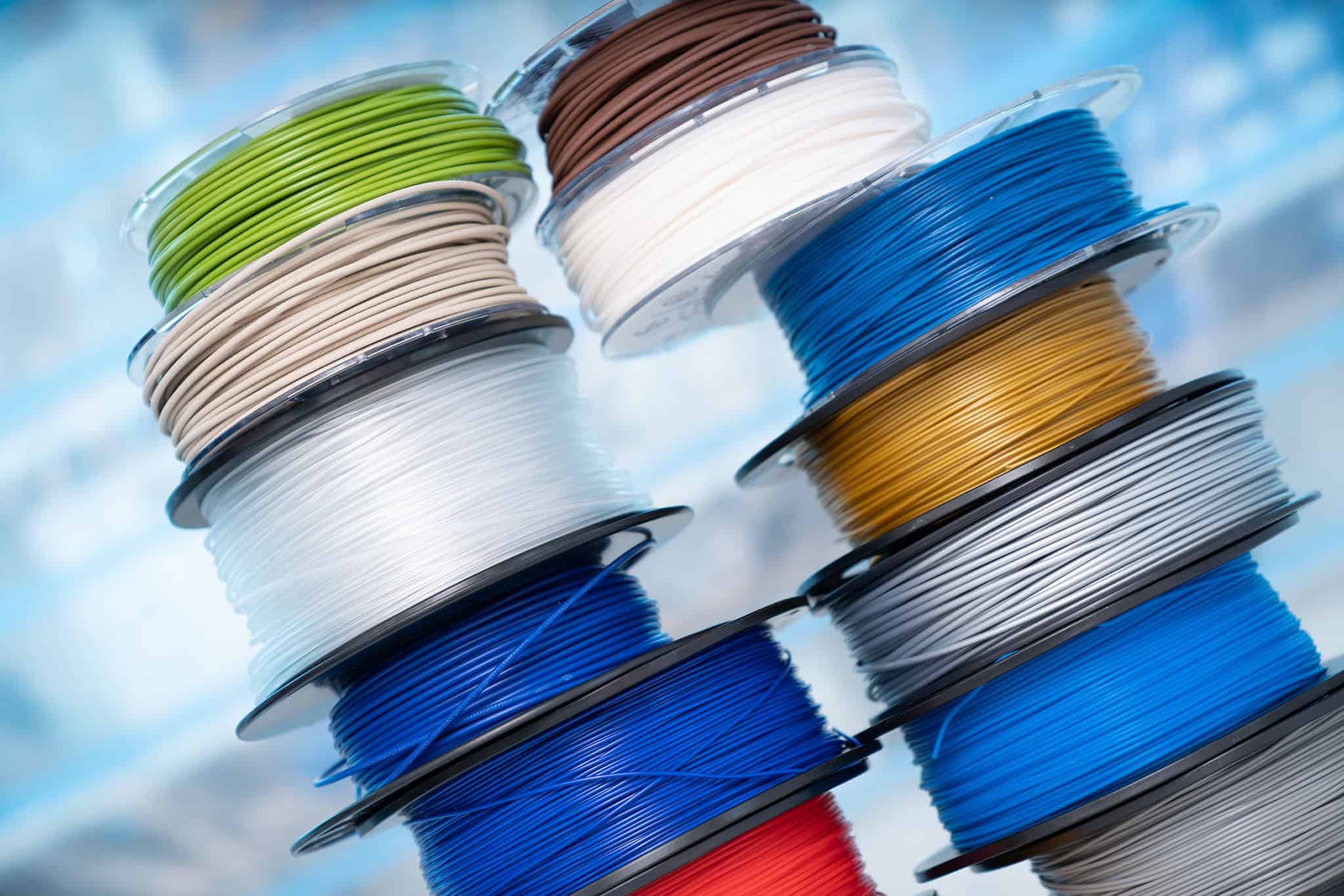This post is also available in:
![]()
Sometimes you have a filament spool in your inventory on which either not much material is left or with which you haven’t printed for a long time. Surely you have already wondered in this situation whether the filament on it is still good.
But, can filament actually go bad? Filaments are hygroscopic and depending on the material type (PLA, ABS, PETG, Nylon, TPU, …) more or less susceptible to humidity. However, 3D printing filaments do not per se go bad or expire. PLA becomes brittle and fragile when stored incorrectly and reacts negatively to frequent or prolonged UV exposure. Nevertheless, filaments can be repaired by drying.
Proper storage can help prevent problems with moist or brittle filament. And if it does happen and the material absorbs moisture, in most cases filaments can be easily dried using simple and sometimes unexpected methods.
Can filament go bad?
No, 3D printing filaments usually do not per se go bad or expire. Filaments are hygroscopic, meaning they absorb moisture from the air to varying degrees depending on the material. While you can leave PLA on the table for a day or two without much concern, it’s a big problem with PETG, ABS, Nylon, PVA, and TPU filaments. The latter filaments can absorb moisture like a sponge.
For some PLA filaments, it is possible that they become brittle and fragile with too frequent or too long improper storage. In addition, PLA does not necessarily react well to long and frequent UV exposure. This does not necessarily make the filament unusable, but increases the risk of the filament breaking or tearing during printing. Therefore, try to use your PLA within a year if possible or store it appropriately.
How do I avoid filament going bad?
Apart from the quality of the filament itself, good and consistent filament quality is just a matter of correct storage.
So avoid leaving unused filament lying around. As mentioned above, ABS, PETG, nylon, PVA and TPUs in particular are very susceptible to humidity. Sometimes it is enough that they are left open overnight to absorb moisture.
Of course, when googling or reading various forum posts, you will also often come across that one or the other person had no problem with filament rolls left open for longer time. Often, in a subordinate clause or a few comments later, you will find a statement from these persons that the air in this room, however, is already very dry.
Regardless of the material type, you should also avoid exposing the filament to long-term UV radiation. Especially PLA does not react particularly well to this. Therefore, filament from higher-priced providers is often packaged in buckets or UV-resistant silver foil.
Proper storage means that the best way to store your filament is as follows:
- In a vacuum-tight bag (optimum case)
- In the manufacturer’s packaging, if your filament comes in a sealable container
- In a special filament storage container
- In a DIY plastic container with silica gel balls. Ideally, the plastic container should be airtight.
If you prefer a DIY solution, you can find three good ideas at Prusa, Tom’s 3D or on Instructables, just to name a few.
How can I tell if my filament has become moist?
You will tell that your filament has become moist by the following effects:
- Cracking or popping noises can be heard again and again during printing. These occur when the small accumulated water droplets in the filament pop due to the heat of the nozzle.
- The strength of the finished printout is lower than usual.
- The adhesion of the material to the print bed is significantly worse.
- The filament shows a much higher tendency to clump or form lumps.
- The surfaces of your expression are unusually rough and textured.
- The extruded material is uneven and is not extruded consistently.
If you store the filament in appropriate containers, you will normally have no problem with the filament becoming moist. Most DIY filament dry boxes us silica gel balls to absorb any moisture from the air. These silica gel balls change the color when they have absorbed too much moisture. In this case, on the one hand, you need to dry the filament in this box before the next use, and on the other hand, you need to renew the silica gel balls in the box.
Tip: You can reuse most silica gel balls by drying them in the stove at ~70°C until they return to their original color.
Can I repair filament?
In most cases, you can repair the filament. To do this, you just need to dry it. You can either do this in special filament dryers or, if you don’t have such a device, do it in the oven or in a dehydrator.
Drying in a filament dryer
Filament dryers are devices that are specifically designed for drying filaments. There are different devices with various drying methods, but ultimately they all serve the same purpose. So if you need to dry filament, you will achieve the best results with this device.
I use the filament dryer from SUNLU for drying filament. You can find a link to the device here in the recommended products.
Basically, your activity is limited to inserting the desired filament spool, selecting the appropriate configuration depending on the material, and waiting until the filament is dried. However, this process can take a few hours.
Drying in the oven
Although the stove in the kitchen is not necessarily designed to dry filament, it can be used for this purpose. It’s best to stick to the following guidelines:
| Material | Temperature |
|---|---|
| PLA | 40-45°C |
| ABS | ~80°C |
| PETG | 60-70°C |
| Nylon | ~80°C |
| PVA | 60-70°C |
| TPU | 80-100°C |
Depending on the material, manufacturer, and condition of the filament, drying can take between 4-8 hours. The oven should be preheated before you put the filament spool in. Try to stay as far away from the glass transition temperature as possible during the drying process.
Even though the oven is a possibility to dry filament, you should still keep in mind that food is prepared in the oven and you’d better use an alternative method if you need to dry filament frequently.
Drying in the dehydrator
Dehydrators function similarly to filament dryers, with the exception that they do not offer specific drying configurations for filament. Drying filament in a dehydrator is not really different from drying it in an oven. You can orient yourself with regard to the temperatures and duration based on the instructions for oven drying.
Can I damage my printer with filament gone bad?
Usually, you cannot damage the printer with bad filament. However, incidents can occur during printing, such as the material, especially PLA, breaking off in the hotend or extruder, which may require disassembling the printer. With other materials like PETG, PVA, ABS, it often results in popping noises or the material not sticking to the print bed. As a result, while the print itself may be unusable for a short time, you typically won’t damage the printer with bad filament.
Typically, you are already aware that you haven’t used the material for a long time and that it may not have been stored properly. In these cases, you’d better take the extra effort in drying the filament first and thus save yourself some repair work or extra rounds of printing.
Can filament expire?
Filaments do not have an expiration date or best before date. If they are stored correctly, you can still use them for quite some time. Either way, you should try to use your filaments as soon as possible. They will not get any better the longer they lie around unused.
As described earlier, it can happen especially with PLAs that they may not be as optimal and easy to print after a year. The filament is not damaged or expired, but you may not necessarily achieve the best printing experiences and results with it.
NOTE!
In this article, I have mentioned and linked to some materials, tools, and similar products. I have compiled all of these products that I can recommend without any hesitation in my recommended products section. These are affiliate links, and for every purchase made through these links, I receive a small commission from the respective seller. If the various articles on the site have helped you and you want to support this blog, I would be very grateful if you use these affiliate links for your purchases. Thank you very much.


